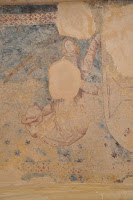Having realised Festa dos Tabuleiros de Tomar, a traditional religious festivity would be held over the weekend and knowing that if I missed it again I wouldn't have another chance but in four years according to the regularity in which it is organised, I took an early train to the village.
Upon arriving there and before the four o'clock Tabuleiros procession I decided to revisit the Convent of Tomar, almost exclusively to be able to see the Charola (Round Church), finally open to the public following a long restoration period.
Before having had entered the Convent I walked to the 1530 entrance of the Convent church currently closed with abundant Manueline motifs and statues of the Virgin Mary, as well as prophets of the Old Testament
As I stood in the rather long queue I looked up and saw a frescoe depicting an image that very much resembled an angel, though there wasn't any explanation as to what the scene was about nor any indication of the date in which it was painted.
The ticket office was located in a former Chapel and whilst waiting to buy the ticket I photographed some of its details.
The Holy Trinity in polychrome stone dating from the 16th century (right)
As soon as I walked in I came across a rather interesting glazed tile tunnel like room, whose ceiling was as outstanding as the walls.
The Washing cloister whose construction is said to have been initiated in 1426 was where the lay brothers and monks did their chores and washed their garments in the ground floor tanks.
I soon came across the New Sacristy built in the late 16th century with a vaulting decoration dating from the time of the Sapnish kingdom of Filipes, which displays the new cross of Christ, the armillary sphere and the Royal arms.
The Portocarreiros chapel built in 1627 was completely covered in 17th century "diamond tip" and "carpet type" pattern glazed tiles, as well as eleven glazed tile scenes depicting the lives of the Virgin Mary and Christ.
I then made my way into the former Room of the Kings and the Nave and choirs including the Upper choir from where I took the first photos of the Charola.
(To be continued)































No comments:
Post a Comment